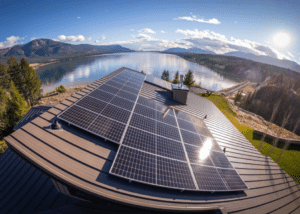HOW A SOLAR DEVELOPER MAKES MONEY

HOW A SOLAR DEVELOPER MAKES MONEY
If you are familiar with commercial real estate development, the risks and rewards associated with solar development are quite similar. This article will use real estate development as an analogy so you can understand how and when your solar developer is making money on your commercial solar project and you can ensure that you are getting the best deal possible.
So what does a solar developer do anyhow? Like real estate developers, solar developers source a project, line up financing (equity and debt), then design and build the project. Commercial solar is installed by an “EPC” contractor which is the equivalent of a “GC”. Hire an ENGINEER to design and permit the project, PROCURE the solar equipment, then hire a qualified installation crew to perform the CONSTRUCTION.
HERE’S HOW THE SOLAR DEVELOPER MAKES MONEY
A solar developer will make two fees: a development fee / construction management fee and a profit at sale of the project (unless they are building a project with their own funds under a buy-and-hold strategy).
Development fees can vary widely but a range of $0.10 to $0.50 per watt is possible depending upon system size and scale. This equates to about 5% to 15% of total project costs. The profit on a sale of a system is function of the system cost and future electricity revenue from the off-taker, just like real estate has a return on cost metric which is a function of annual rent and building cost.
Like real estate, you can sell a solar development project at different phases: Pre-NTP, NTP, or PTO (more on that later). The value of the project increases as each milestone is reached. Real estate can be sold as raw land, land with entitlements, a completed building, or a fully stabilized building. The phases of a solar project are similar.
NTP (NOTICE TO PROCEED): Finding a solar project and “entitling” it, is where the action is at. This is where solar developers make the highest ROI with a relatively small amount of capital out-of-pocket (around $20,000 for an average commercial solar project). It’s arguably the most difficult part because you are securing a deal. In real estate, a developer can tie-up land, put it in escrow, then start working on the entitlements to build a project. Once the real estate developer has the entitlements, they can close on the land and obtain cheap financing to build a project.
Once a solar developer has a project at NTP, the developer can go to a variety of financing sources including wall street funds, debt lenders, and private investors to obtain financing to build your project. Another option is the developer can sell your entitled project for a profit to an investor who wants to build and own the project. Many large solar funds do not take pre-development risk, so at NTP the pool of investors becomes much larger. Investors are looking to make somewhere around a 10-12% unlevered IRR (after thetax credits) at this point because there is still execution and construction risk. The solar developer is going to make the spread between their out-of-pocket costs and whatever the buyer will pay by backing into the 10-12% IRR target.
PRE-DEVELOPMENT
Most investors are not willing to take pre-development risk, so the solar developer must use their own cash for expenses leading up to the construction of the project. A solar developer needs a few signed documents and approvals to have a real deal and make money. These are like having entitlements for a piece of raw land to develop for real estate.
Site Control / rights to your roof or parking lot.This can come in the form of lease agreement, easement, or similar agreement. This can also come in the form of an “option” to control your roof / site once all of the approvals are received. For example, the building owner will give the developer exclusive rights to develop their solar project for a period of 6-12 months in exchange for consideration. The developer is incurring legal fees and spending time with the building owner negotiating these documents.
Off-taker PPA (Power Purchase Agreement).All projects need someone buy the electricity produced by the system at a set price. The buyer is called the “off-taker”. The higher the electricity price, the more valuable the solar project. The price might be fixed or it could be a floating number that mirrors utility costs (i.e. you sell power for 5% less than the utility would have charged). The PPA could be with (A) one or more tenants in a building (NNN leases); (B) the building owner who is charging tenants for electricity and seeking reimbursement (gross leases); (C) the owner-user of a building; or (D) a municipal or government program such as community choice aggregator.
Design & Engineering Documents: A solar system layout, an electrical one line diagram, and a structural analysis of the site to verify the roof can support the system – all stamped by a Professional Engineer will be needed. Once the above documents are obtained, the solar developer can submit to the city or county planning department for approval. Engineering plans will cost the developer $5,000 to $20,000 for a typical commercial real estate project. Engineers can turn around a plan set within 2-4 weeks in most cases and the building permit will take a few weeks as well, depending on jurisdiction.
Interconnection agreement.This is the agreement that allows your building / solar project to feed into the grid of the local utility so that the building can draw power from the grid when solar electricity is not available, but also send any excess power generated by your project back into the grid. The solar developer may choose to submit an application to the utility to obtain approval for interconnection in parallel to the building permit application process. Interconnection costs vary by jurisdiction but about $5,000 is a ballpark estimate. The site layout and one line diagram from the engineering plans will be required to submit Interconnection.
Once the solar developer has all of the above approvals in-hand, this is considered “NTP” or notice-to-proceed. The hard work is done, and the developer can cash-in for having a deal just like a real estate developer can sell a fully entitled project for a profit.
PERMISSION TO OPERATE (PTO)
Now you are at NTP, next step is to procure the equipment and construct the project. Solar developers who want to make even more money will build the project through “PTO” or permission to operate. They will make more overall dollars, but the ROI is much lower because they are fronting all of the hard costs for materials and labor to construct the project.
The engineer should provide the solar developer with an exact bill of materials which can be used to solicit quotes from vendors to procure the equipment. A good system will have Tier 1 panels as rated by Bloomberg with a warranty of 25 years. The final step is to hire a qualified contractor to install the racking, solar panels, and complete all of the wiring for your project. Depending on size, a typical solar project for a commercial real estate building can be installed in about 2-6 weeks once materials arrive on site.
Once the physical components are installed, the system is ready to energize / commission. The contractor will ensure that the system is properly connected to the meter and that the interconnection requirements are met. The city will inspect the site, verify documentation, and then sign off on the final building permit. The formal industry term for this is PTO (permission to operate from the utility). The date the project is actually turned on, and responsibility handed over from the contract to the site owner is COD (Commercial Operation Date). Once the system is at PTO, this similar to a building that has a Certificate of Occupancy.
Execution and construction risk are no longer an issue, which means that even more investors are willing to buy the project from a solar developer. It’s the equivalent of a stabilized project, although there will still be some bugs to work out. At this phase, depending on the ultimate credit of the off-taker (or buyer of the electricity) an investor is looking to earn a 7-9% unlevered IRR. The cost of the system including the development fee that the solar developer is charging, the PPA price, annual escalations, projected building vacancy, and term of agreement all impact the price that the buyer is willing to pay, and hence impact the overall IRR of solar project.
PORTFOLIO SALE
Like real estate, the institutional funds have a minimum check size to do a transaction. Developers will need to build up a portfolio of at least 2-3 mW of projects. Now they can go sell this portfolio for >$5 million and hopefully make even more money.
At Solar CFO, we are giving our clients the truth about commercial solar and making your transaction completely transparent. Please contact me if you have any questions[email protected] or visit our websitewww.solarcfo.com. P.S. Ask me in a couple years if this is a good path to get rich in the solar business!
Credit Link: https://www.linkedin.com/pulse/how-solar-developer-makes-money-casey-gilley/



 Source:
Source: 



